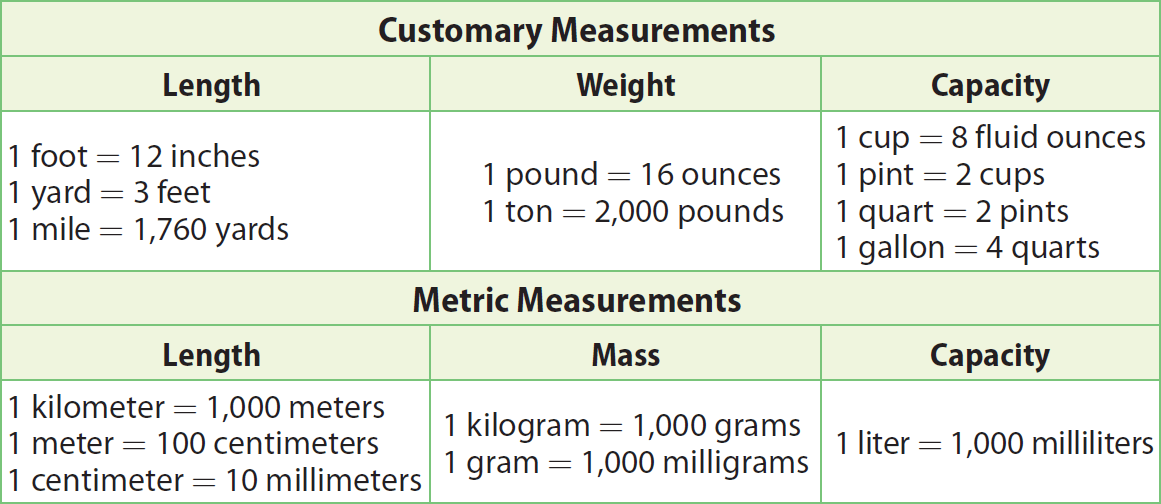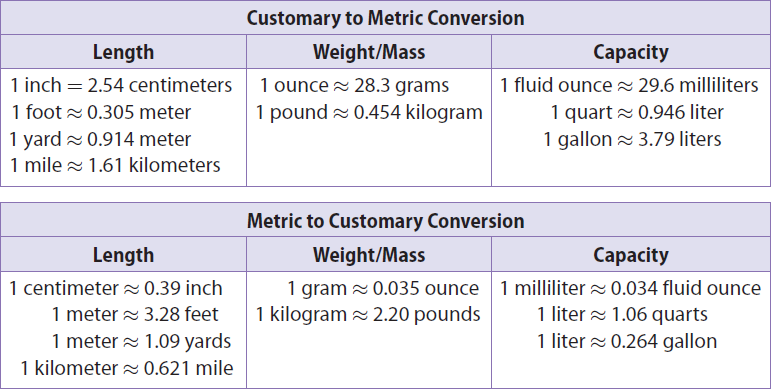USING CONVERSION FACTORS TO SOLVE PROBLEMS
Subscribe to our ▶️ YouTube channel 🔴 for the latest videos, updates, and tips.
We solve many real word problems by converting units within measurement system (metric or customary) and between measurement systems (customary to metric or metric to customary).
We use conversion factors to convert units within measurement system and between measurement systems.
The chart given below can be used to convert units within measurement system.

The chart given below can be used to convert units between measurement systems.

For example,
From the above chart, in the length section of customary to metric conversion, we have
1 inch = 2.54 centimeters
If we convert inches into cm, the conversion factor is
2.54 cm / 1 inch
If we convert cm into inches, the conversion factor is
1 inch / 2.54
Example 1 :
Elena wants to buy 2 gallons of milk but can only find quart containers for sale. How many quarts does she need ?
Solution :
Step 1 :
We want to convert gallons to quarts.
Identify the ratio that compares the units involved.
The units gallons and quarts are customary units of capacity.
Find the relationship of those units in the capacity section of the customary measurements table.
4 quarts = 1 gallon
The appropriate conversion factor is 4/1.
Because when we multiply 2 gallons by that conversion factor, we can divide out the common unit gallons. The resulting unit is quarts.
Step 2 :
Multiply the given measurement by the conversion factor.

Elena needs 8 quarts of milk.
Example 2 :
A container of a powdered fruit drink mix has a mass of 1.25 kilograms. What is that mass in milligrams ?
Solution :
Step 1 :
You want to convert kilograms to milligrams.
There is no equation in the table that relates kilograms and milligrams directly. However, we can convert kilograms to grams first. Then we can convert grams to milligrams.
Step 2 :
Multiply the given measurement by the conversion factor.

We can also do both conversions at the same time.

A mass of 1.25 kilograms is equal to 1,250,000 milligrams.
Example 3 :
While working out, Alima adds 11.35 kilograms to the machine. About how many pounds does she add ?
Solution :
Step 1 :
Find the conversion factor for converting kilograms to pounds
1 kilogram ≃ 2.20 pounds
Write the conversion factor as a ratio
2.20 pounds / 1 kilogram
Step 2 :
Convert the given measurement.

Alima adds about 25 pounds.
Example 4 :
Bob’s driveway is 45 feet long by 18 feet wide. He plans to pave the entire driveway. The asphalt paving costs $24 per square meter. What will be the total cost of the paving ?
Solution :
Step 1 :
First find the dimensions of the driveway in meters.
Convert each measurement to meters.
Use 1 foot ≃ 0.305 meter.

Step 2 :
Next find the area in square meters.
Area = length × width
≃ 13.725 × 5.49
≃ 75.35025 square meters
Step 3 :
Now find the total cost of the paving.
square meters × cost per square meter = total cost
75.35025 × $24 ≃ $1,808.41
Total cost of paving is $1808.41.
Example 5 :
Peter is overweight. He is 105 kg. His aim is to lose 500 g per week. If he manages this, how many weeks will it be until he is 90 kg?
Solution :
Peter's weight = 105 kg
Each week he is trying to reduce = 500 grams
Number of weeks is taken to have the weight of 90 kg = n
Converting grams to kg
1 kg = 1000 grams
dividing by 2, we get
1/2 kg = 500 grams
0.5 kg = 500 grams
105 - 0.5n = 90
Adding 0.5 n on both sides
105 = 90 + 0.5 n
Subtracting 90 on both sides
105-90 = 0.5n
15 = 0.5n
Dividing by 0.5 on both sides
15/0.5 = n
30 = n
So, it takes 30 weeks to have the weight of 90 kg.
Example 6 :
30 g serving of a certain breakfast cereal has 0.5 g of salt. How much salt would that be in milligrams
Solution :
1 gram = 10 milligrams
30 g serving will have 0.5 gram of salt
Converting grams to mg
30 grams = 300 milligrams
From the information,
30 grams of serving = 0.5 grams of salt
300 grams of serving = 10 x 0.5
= 5 grams of salt
Using the conversion above,
5 grams = 5(10)
= 50 milligrams
Example 7 :
Chase measured a line for his art project. It is 200 millimeters long. How many centimeters is the line?
Solution :
1 cm = 10 mm ----(1)
200 mm = ? cm
Multiply by 20 on both sides
20 cm = 200 mm
So, the length of the line is 20 cm.
Example 8 :
Cheryl is moving to a new house. Her old house is 3 kilometers from her new house. How many meters is the old house from the new house?
Solution :
1 km = 1000 meters
3 km = 3(1000)
= 3000 meters
So, the distance between the old house and new house is 3000 meters.
Subscribe to our ▶️ YouTube channel 🔴 for the latest videos, updates, and tips.
Kindly mail your feedback to v4formath@gmail.com
We always appreciate your feedback.
About Us | Contact Us | Privacy Policy
©All rights reserved. onlinemath4all.com

Recent Articles
-
US Common Core K-12 Curricum Algebra Solving Simple Equations
Jan 07, 26 01:53 PM
US Common Core K-12 Curricum Algebra Solving Simple Equations -
10 Hard SAT Math Questions (Part - 4)
Jan 05, 26 06:56 PM
10 Hard SAT Math Questions (Part - 4) -
10 Hard SAT Math Questions (Part - 3)
Jan 05, 26 06:34 PM
10 Hard SAT Math Questions (Part - 3)

